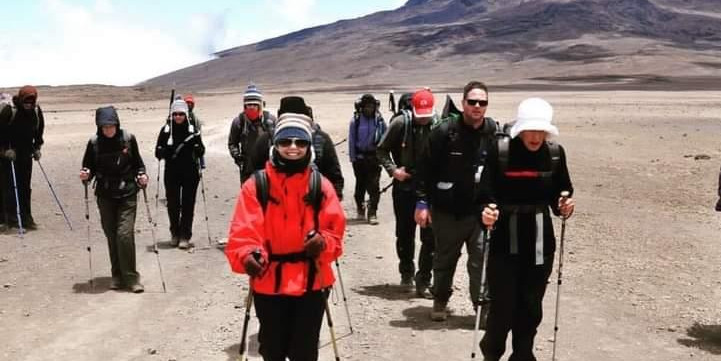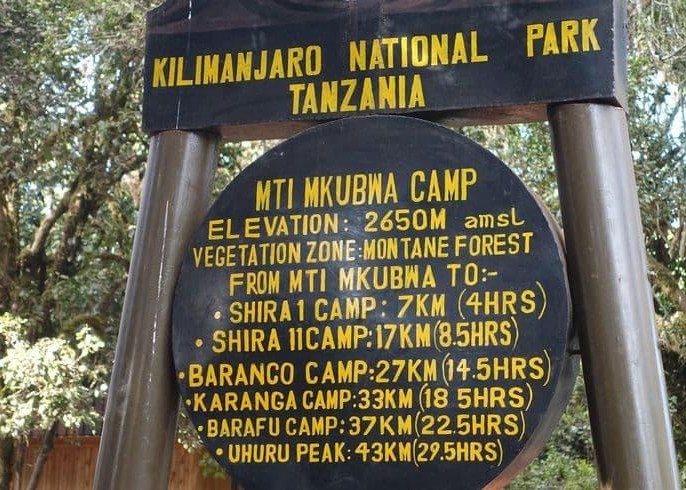Mount Kilimanjaro: Lemosho Route 7-Day Trek
7 days Lemosho Route Trek

Embark on a week-long expedition to Mount Kilimanjaro via the Lemosho Route, exploring diverse ecosystems from lush rainforests to arid alpine deserts, all while enjoying stunning views.
Trip Description
Accomodation
Stay program
day 1:
Lemosho Gate (2385 m) – Big Tree Camp (2780 m)After breakfast at the lodge, you will be taken to the Lemosho Gate at 2385 m. On the way, you will pass many traditional villages and farmland. After registration at the gate, you will set off on foot, gradually going uphill through the forest to Big Tree Camp at 2780 m. On arrival at this shaded forest camp, your porters will have set up camp already and will greet you, introduce themselves, then encourage you to join them in singing the Kilimanjaro song. You will overnight here and enjoy a nutritious cooked supper before going to bed.
day 2:
Big Tree Camp (2780 m) – Shira Camp 2 (3900 m)A longer day awaits. Starting off through the forest, you will notice how the vegetation gradually changes; the trees are thinning out and more shrubs appear as you ascend. You will see Lobelias and Erica’s and cross Shira Ridge. After about five hours of hiking, you will stop for a hot lunch at Shira Camp 1. This spot has great views of the sister mountain Mt Meru and the Rift Valley below. The afternoon stretch will take about three hours and you will gain 400 m in altitude. Still, the landscape changes as you cross an area that was molten lava many years ago. Strange plants dot the landscape – giant senecios – you should be close to Shira Camp 2. This is your camping spot for the night. If the weather is good, you should see the summit – an awesome view at sunset.
day 3:
Shira Camp 2 (3900 m) – Lava Tower (4640 m) – Barranco Camp (3950 m)Lots of ups and downs today. You will gain about 700 m in height and will certainly feel the difference, only to descend again for tonight’s camp at Barranco. The up and down will help your body acclimatize. During the day you will reach an altitude of over 4500 m above sea level. The day starts with an uphill above Shira Plateau towards the Lava Tower at 4640 m. The landscape is now an almost bare alpine desert and resembles an entirely different world. Descending again, you will start seeing more vegetation – lobelias and the surreal senecios in the sweeping Barranco Valley. After about seven hours (from when you started) you should reach Barranco Camp, by many consider the best camp on Kilimanjaro. Snacks and hot drinks are waiting as usual.
day 4:
Barranco Camp (3960 m) – Karanga Camp (4035 m)Don’t be discouraged by what you see in front of you today; the Barranco Wall, known to the guides and porters as the “Breakfast Wall”. It is not as intimidating or frightening as it seems, though it is one of the steepest sections of the route. “Pole pole”, slowly slowly, as they say on the mountain, and you will reach the top. Use your hands if you need to, listen to the encouragement of the guides, and soon you will admire the spectacular views from the top. You will continue along the undulating ridge. Focus on Kibo Peak and the southern glacier, and before you know it, you will be at Karanga Camp in time for lunch. The rest of the afternoon can be spent relaxing and or enjoying the scenes around the camp.
day 5:
Karanga Camp (4035 m) – Barafu Camp (4640 m)After the usual breakfast of hot porridge, eggs, and fruit, you will set off to Barafu Camp. You should reach the overnight camp (at 4640 m) after about four hours of increasingly sparsely littered with volcanic rocks. The afternoon is at your leisure; relax or read and prepare mentally for the summit attempt that will start in the early morning hours. Or you can ask your guide to take you on a short round trip to the top of a ridge a couple of hundred meters higher (close to 4900 m) to get a head start on the acclimatization process for the impending summit climb. Try to eat well and drink lots of water before going to bed, even if it’s a struggle. You have a few hours to sleep before the wake-up call at around 00:00.
day 6:
Barafu Camp (4640 m) – Uhuru Peak (5895 m) – Mweka Camp (3080 m)After waking up and having some tea and biscuits, you will set off, following a string of headlamps as they move slowly upwards… It will be cold and dark. Keep going slowly and steadily, focus carefully on your breathing, and eat and drink when possible but without taking any long breaks (it’s too cold to halt for long), then you will reach Stella point on the crater’s edge between five and seven hours later. Keep going for an hour or two and you will finally be on the roof of Africa – Uhuru Peak. You will probably spend between ten and twenty minutes in the cold and thin air at 5 895m – take in this memorable achievement and admire the view and the early morning sun over the landscape below. A fast and gravelly descent follows. At around noon you should reach Barafu camp again where the crew is waiting. You will have a warm lunch and rest for an hour or so before setting off again. After about three hours, you should reach Mweka Camp (3 000 m) where you will sleep deep and soundly tonight.
day 7:
Mweka Camp (3080 m) – Mweka Gate (1630 m)The last day on the mountain starts with breakfast. Then your crew will congratulate you on your achievement; there will be more singing, team photos, and hugs, then the tips will be distributed to the crew. Now, the last stretch of about three hours to Mweka Gate lies ahead. It should be an easy descent through the rainforest. At the gate, our driver will be waiting to return you to the hot showers and cold drinks of your lodge. Jump in the pool or dress in fresh clothes before meeting in the bar for a celebratory drink and a debriefing, during which your certificate of achievement will be handed over. Well done! Tonight you will enjoy supper at the lodge and then perhaps head out for some more celebratory drinks if the fatigue hasn’t taken over yet.
- Duration : 7 days
- Price : From €1,990.00 per person
- Destinations : Tanzanie
A website by
Customize your trips with Quotatrip and receive tailor-made offers directly in your inbox.
Discover a country
